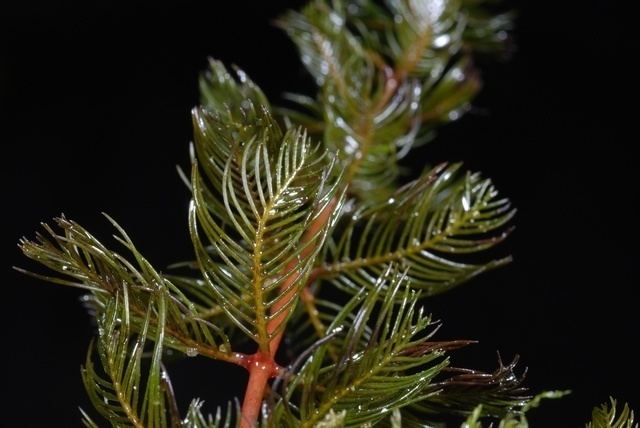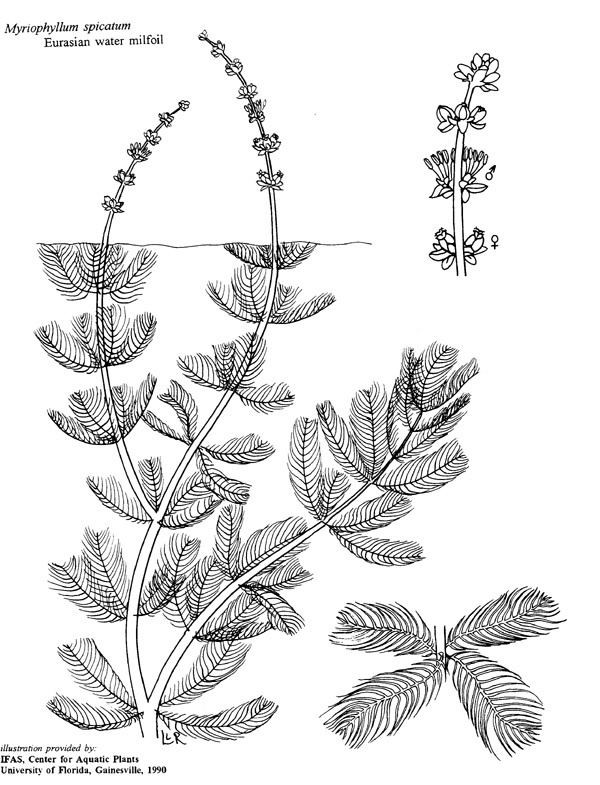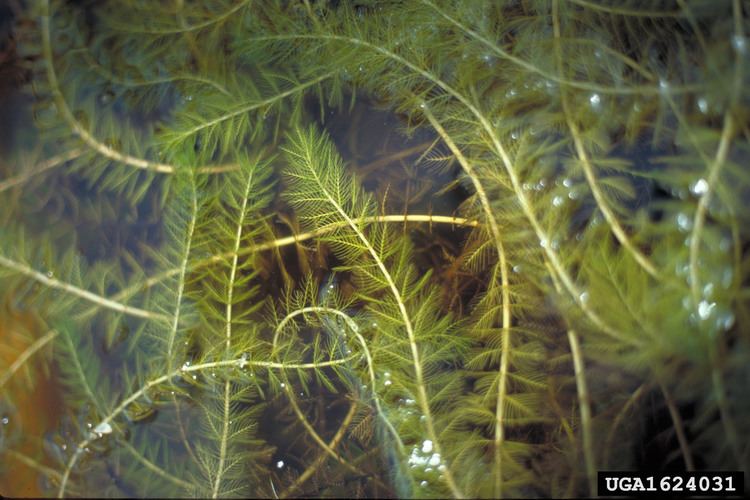Higher classification Myriophyllum | Genus Myriophyllum Rank Species | |
 | ||
Similar Myriophyllum, Potamogeton, Potamogeton crispus, Ceratophyllum demersum, Myriophyllum verticillatum | ||
Eurasian water milfoil myriophyllum spicatum
Myriophyllum spicatum (Eurasian watermilfoil or spiked water-milfoil) is native to Europe, Asia, and north Africa. It is a submerged aquatic plant, and grows in still or slow-moving water.
Contents
- Eurasian water milfoil myriophyllum spicatum
- How to identify eurasian water milfoil myriophyllum spicatum
- Description
- Distribution
- Introduced areas
- Impact
- Control
- Chemistry
- References

How to identify eurasian water milfoil myriophyllum spicatum
Description

Eurasian watermilfoil has slender stems up to 175 cm long. The submerged leaves (usually between 15–35 mm long) are borne in pinnate whorls of four, with numerous thread-like leaflets roughly 4–13 mm long. Plants are monoecious with flowers produced in the leaf axils (male above, female below) on a spike 5–15 cm long held vertically above the water surface, each flower inconspicuous, orange-red, 4–6 mm long. Eurasian water milfoil has 12- 21 pairs of leaflets while northern watermilfoil M. sibiricum only has 5–9 pairs. The two can hybridize and the resulting hybrid plants can cause taxonomic confusion as leaf characters are intermediate and can overlap with parent species.
Distribution
Myriophyllum spicatum is now found on all continents except Australia, where there have been only anecdotal sightings, and Antarctica.
Introduced areas

Myriophyllum spicatum was likely first introduced to North America in the 1940s where it has become an invasive species in some areas. By the mid 1970s, watermilfoil had also covered thousands of hectares in British Columbia and Ontario, Canada. Eurasian watermilfoil is now found across most of Northern America where it is recognized as a noxious weed.
Impact

In lakes or other aquatic areas where native aquatic plants are not well established, the Eurasian plant can quickly spread. It has been known to crowd out native plants and create dense mats that interfere with recreational activity. Eurasian watermilfoil can grow from broken off stems which increases the rate in which the plant can spread and grow. In some areas, the Eurasian Watermilfoil is an Aquatic Nuisance Species. Eurasian watermilfoil is known to hybridize with the native northern watermilfoil (M. sibiricum) and the hybrid taxon has also become invasive in North America. It is known from across the USA upper midwest (Lake of the Woods in Bremen Indiana, Minnesota, Michigan, Wisconsin) and in the Northwest (Idaho, Washington).
Control

The aquatic moth Acentria ephemerella, the water veneer moth, feeds upon and damages this water milfoil. It has been used as an agent of biological pest control against the plant in North America. The milfoil weevil (Euhrychiopsis lecontei) has also been used as biocontrol. Another method for biocontrol is Grass Carp, (one of the Asian Carp species) which have been bred as sterility, is sometimes released into affected areas, since these fish primarily feed on aquatic plants and have proven effective at controlling the spread. However, the carp prefer many native species to the milfoil and will usually decimate preferred species before eating the milfoil. In Washington State the success rate of Grass Carp has been less than expected. They were used in 98 lakes and 39 percent of them had no submerged plant life left after only a short time.

Since roughly 2000, hand-harvesting of invasive milfoils has shown much success as a management technique. Several organizations in the New England states have undertaken large scale, lake-wide hand-harvesting management programs with extremely successful results. Acknowledgment had to be made that it is impossible to completely eradicate the species once it is established. As a result, maintenance must be done once an infestation has been reduced to affordably controlled levels. Well trained divers with proper techniques have been able to effectively control and then maintain many lakes, especially in the Adirondack Park in Northern New York where chemicals, mechanical harvesters, and other disruptive and largely unsuccessful management techniques are banned. After only three years of hand harvesting in Saranac Lake the program was able to reduce the amount harvested from over 18 tons to just 800 pounds per year.
Chemistry
Myriophyllum spicatum produces ellagic, gallic and pyrogallic acids and (+)-catechin, allelopathic polyphenols inhibiting the growth of blue-green alga Microcystis aeruginosa.
